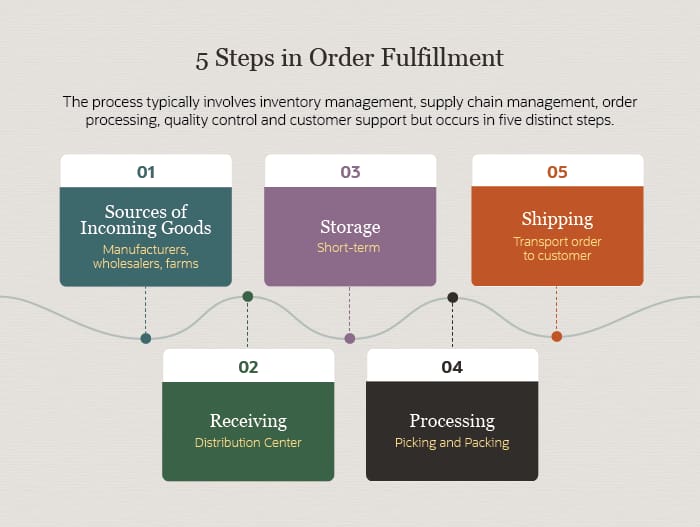Blog Credit: Lisa Schwarz, August 20, 2020 (What is Order Fulfillment? 7 Step Process & Key Strategies | NetSuite)
While order fulfillment is, by definition, the method by which a company processes a sales order to the customer’s specifications, that understates its importance. Customers hold more power than ever, are more informed and have higher expectations. Efficient order fulfillment is key to your brand’s reputation, your company’s profits and your ability to retain clients.
Without sales there is no business. Without order fulfillment, there are no sales.
Achieve Better Business Results with NetSuite & CE
Grow and scale your business while gaining a competitive advantage with NetSuite’s best-in-class integrated cloud business software and CE’s expertise in NetSuite implementation, advisory, managed services and direct staffing. Let us show you how to leverage our direct staff pool of resources to realize better insights, organizational efficiency, increased profitability and improved relationships with your suppliers and customers – and ultimately take your business to the next level.
Contact CE today to learn more about our NetSuite consulting services.
"*" indicates required fields
Key Takeaways
- Order fulfillment is a critical business task for many product-based businesses.
- An efficient order fulfillment operation requires coordinating with multiple departments and outside partners.
- An ERP often plays an essential role in managing the order fulfillment process.
Order Fulfillment Explained
A new sale is almost always something worth celebrating, but the work isn’t done until the order is fulfilled, and the customer has the order in hand. Order fulfillment is the critical task of assembling the order and shipping it off to the customer, plus the supporting processes that support those tasks.
The complete order fulfillment lifecycle is made up of five primary steps starting with strategic sourcing and ending with shipping. Many businesses include inventory management, supply chain management, order processing, quality control, and customer support in the umbrella of order fulfillment.
Much of the order fulfillment process can take place under one roof in a well-organized warehouse, depending on the size of your business. Many small businesses handle order fulfillment themselves in-house through a simple process. Large enterprises require a more complex, multi-layer distribution center strategy. But in either case, the main goal is efficiently getting the customer what they ordered as quickly, reliably, and inexpensively as possible.
Order Fulfillment Process: How Does It Work

-
Receiving Inventory
Goods may come from a third party, another company department or a company warehouse; a pipeline (as with oil, fuel, water or some other fluid product); as digital data from a database; or in a variety of forms from other external or internal sources.
In any case, the incoming inventory must be counted, inspected and inventoried to ensure the proper amount was received and the quality is acceptable. SKUs or bar codes on the arriving products are used in the receiving and storage processes, and to retrieve goods from internal storage later.
-
Inventory Storage
Once goods are received in the fulfillment center, they are inventoried and either immediately disbursed or sent to short- or longer-term storage. Items are ideally stored just long enough to help organize the orderly distribution of goods for existing sales, rather than to hold product for future sales.
-
Order Processing
An order processing management system dictates the product picking and packing activities per each newly received customer order. In the online marketplace, order management software can be integrated with the shopping cart on an ecommerce website to automatically initiate order processing.
-
Picking
A picking team or automated warehouse robots select items from the warehouse according to a packing slip’s instructions. The packing slip contains specific information, such as a list of item SKUs, product colors, sizes, number of units and location in the distribution center’s warehouse.
-
Packing
Packing materials are selected by a packing team or automated fulfillment robots to achieve the lowest practical dimensional weight, which is calculated by multiplying package length times width times height. Since space on delivery trucks is at a premium, optimizing dimensional weight (or DIM weight) is important to speed transport while also potentially lowering shipment costs.
Further, packing teams often include return shipping materials and labels in case the customer wishes to exchange or return the item for a refund later.
-
Shipping
The order is sent to a transportation channel or shipping node to be shipped to the customer. Shippers and carriers—be they freight lines or airlines, FedEx, UPS, the U.S. Postal Service (USPS) or other carriers—determine freight billable costs by whichever is greater: actual package weight or its dimensional weight.
Even if the actual weight is low, such as with a t-shirt, packing it in the lowest DIM is often worth it to keep the packaging from adding significantly to the overall package weight. Also, most carriers have packaging rules to optimize their own profits from the shipping space they have available. Failing to meet those requirements can delay shipments if carriers refuse to accept the order.
-
Delivery
It is common for shipping routes to include more than one carrier. For example, FedEx may pick up a package at the fulfillment center that will later be delivered by the USPS to the customer’s home. There are many reasons for these hybrid shipping methods. One common example is that the USPS delivers even to remote areas where most other commercial carriers do not. It’s simply more practical to use the USPS for the last mile of delivery in those cases.
-
Returns Processing
Returns processing begins with including shipping materials and a return label with the original customer’s order. When a customer does return a product for exchange or a refund, the process must be executed carefully to ensure it’s appropriate to restock it. Obviously if the product malfunctions, it can’t be restocked. Nor can a soiled item. Returns processing involves quality control checks and sorting returned products accordingly. Return products are then restocked, returned to a vendor or manufacturer for a distributor refund or credit, or sent to a recycling center.
Why Is Order Fulfillment Important?
Companies make money by selling goods, products and services to businesses or direct to consumers. No matter whether you’re B2B or D2C, the sale is not complete until the sold items are received by that customer. Order fulfillment is how companies complete the sale and it’s at the heart of every business.
Order Fulfillment Challenges
Inventory Management
Running out of stock leads to customer dissatisfaction, failures in the overall customer experience and harm to brand reputation. It is difficult for companies to repair the damage once it’s done. But there are exceptions: Customers tend to be more forgiving if shortages and delays are caused by a widespread weather event, a natural disaster or a Black Swan event.
Demand Planning
On the other hand, keeping too much stock on hand drives up storage and carrying costs. It also increases your risk since demand for those items may drop before you get them sold. It’s important to carefully predict and plan for demand levels in order to keep adequate supplies in stock without ever dipping too low or stocking too much of any given item.
Logistics Planning
Slow or missing deliveries, broken items and battered or wet packaging are all factors that can harm a company’s reputation and future sales, and in turn its profitability. It is essential then to carefully manage logistics so shipping doesn’t go awry and items aren’t damaged. Simply put, customer satisfaction is greatly affected by logistics, so keep a close eye on end-to-end—or warehouse to mailbox—performance.
Supply Chain Execution
Having a supply chain strategy entails evaluating cost versus benefit tradeoffs in terms of operational choices. For example, a company may choose a sole supplier for a given product to gain price breaks for the higher purchase volume. That’s also a good strategy to gain priority status with the vendor, which can make a difference in getting goods on time during periods of high demand. However, using a sole supplier model can backfire if anything goes wrong for that vendor—from employee strikes to natural disasters to their own supply shortages.
Supply chain execution (SCE) is the flow of tasks in the supply chain. Software applications are used to manage every activity within that chain. Specifically, material management, tracking the physical status and movement of the product, tracking data shares and data feeds, and managing financial information—particularly transactions among all parties.
SCE typically involves the use of multiple applications, such as order management, inventory management, warehouse management, transport management and logistics software.
Order Fulfillment Best Practices
Remember that the efficiencies to be gained in order fulfillment depend on great organization. Best practices boil down to organize, organize.
Start with the basics. Streamline your receiving processes so incoming shipments are processed quickly and damaged goods returned swiftly to the manufacturer for replacement. This will go a long way in preventing back-orders or long wait times for your customers.
Organize your warehouse for more efficient picking times. Place hot-ticket items upfront and close to human or robot pickers and packers. Place other items in your warehouse according to demand, with items least in demand being at the very back.
Organize shipping and logistics so you get the fastest possible delivery times to customers at the least cost. But also plan a shipping backup strategy in case something goes wrong, or carriers unexpectedly raise rates too high for your margins.
Automate as much as you can to save labor costs, improve working conditions, and make operations safer.
How Do You Choose an Order Fulfillment Strategy?
Businesses have several choices when deciding on an order fulfillment strategy. Depending on the skills and resources available in your company, you may prefer either internal fulfillment or outsourced fulfillment.
If you have the means in-house, you gain more control over operations and costs by handling fulfillment internally. If your company’s in-house talent and resources are somewhere in the middle, you may want to opt for a hybrid model to give you some of the benefits of both worlds.
If fulfillment and logistic skills and resources are scarce, you may be better off outsourcing order fulfillment completely. This allows your team to focus its efforts on producing and selling the product, and it often leads to more predictability. With internal fulfillment, you employ the staff, own the warehouse, and have to make sure every order goes out perfectly. When you outsource order fulfillment, many of those challenges are no longer your problem.
To make the right decision for your business, look at the product, potential fulfillment options, and fulfillment costs. A detailed financial analysis should guide you to the best solution.
Order Fulfillment Models
Order fulfillment models have been refined over many decades, but the basics hold true, and that is for very sound business reasons.
What are the types of order fulfillment?
There are four order fulfillment models to choose from: in-house, outsourcing, drop shipping and hybrid. Each model fills specific business needs.
- In-house: The in-house model simply means that all steps in order fulfillment are performed internally.
- Third-party: This model entails outsourcing all order fulfillment activities to an order fulfillment vendor or other third-party.
- Drop shipping: The order is produced and shipped by the manufacturer. On the pro side, this lowers the barrier to entry and minimizes overhead costs, key for startups and ecommerce companies. It also eliminates the middleman, which can potentially save the buyer money. On the cons side, it can also strip control from merchants, particularly in terms of inventory management and order fulfillment. It can also greatly delay shipments to customers, since many manufactures are in other countries, far from the merchant’s customer base. In that case, shipping may take more time and cost more or a distribution center is set up and items ship from there.
- Hybrid: A hybrid model simply means a combination of two or more of the three models above. For example, a company may choose to handle order fulfillment of all or just popular products internally, but also choose to outsource fulfillment during peak periods, such as the holidays, and drop ship big and bulky items directly from the manufacturer.
7 Tips to Improve Order Fulfillment
- Choose the best order fulfillment ERP system: Start by choosing a system that offers end-to-end tracking for orders, inventory, and all other aspects of your business. An ERP like Oracle NetSuite features helpful modules to help you and your team track the entire business, including order fulfillment, finances, and human resources, through one secure, cloud-based system that’s always accessible.
- Integrate with suppliers and vendors: Modern ERP systems enable you to integrate directly with suppliers and vendors. For example, your entire restocking and accounts payable process can tie together and run without extensive human intervention. Set up your rules, connect with your vendors and suppliers, and your systems can handle things from there.
- Set clear customer expectations: Most businesses are wise to heed the business adage to “under promise and over deliver.” Customers are likely willing to work with you and your expected timeline, particularly in the post-COVID era where delays are commonplace. Set clear expectations when you receive an order, then work hard to meet those expectations. If anything looks to be delayed, communicate the issue as soon as possible so your customer knows what to expect and isn’t disappointed.
- Optimize inventory management: If you hold too little inventory, you risk running out of stock and coming up short for a customer order. When you hold too much inventory, working capital and storage costs may spiral out of control. A quality inventory management module in your ERP is tremendously helpful for this task.
- Select the right order picking strategy: When an order comes in, chances are you don’t have a fleet of automated warehouse robots to pick and package orders. Using your human capital effectively is vital to keeping costs down and efficiency up in your order fulfillment operation. Common order picking strategies include discrete order picking, where orders are picked one at a time, zone and batch order picking, where multiple orders are picked at once, and other strategies intended to limit travel time and increase picking speed.
- Treat your shipper as an essential partner: Organizations like the United States Postal Service, UPS, FedEx and DHL play a key role in your fulfillment process. Don’t treat your shipper like any other vendor. Spend the time and effort negotiating the best deal and delivery schedule for your fulfillment needs, and work proactively with your shipper to avoid delays.
- Prepare for customer service and returns: As much as you try to leave every customer with a perfect experience, mistakes, defects, and delays happen from time to time. Whether the issue was your fault, your customer’s, or a vendor’s, it’s best to be prepared to make it right.
Improve Order Fulfillment with Order Management Software
When building your order fulfillment process, don’t discount the value of high-quality order management and fulfillment software. When you use the right ERP, these systems seamlessly work together, enabling the most efficient and enjoyable sales process possible.
When you shop online, you may not realize that you’re interacting with a series of interconnected systems to handle ordering, shipping estimates, payments, warehouse fulfillment, and delivery. Some companies choose a hodgepodge approach where they use different tools for each other these functions while others choose an order management software that fits into a larger ERP strategy.
NetSuite Order Management is a part of the NetSuite ERP that brings owners, managers, and fulfillment teams quick access to essential information as the system tracks every order through your sales and fulfillment process. Users can securely view and any order, and the system handles complex order needs such as split orders and outsourced drop shipping.
The Order Management module enables ordering, fulfillment, and returns from anywhere in the world with a single data set and automated order management process. That’s a big help for any business involved with order fulfillment.
Whether you’re are the exciting beginning stages of a startup or have decades of order fulfillment experience, it’s never too late to look at your order fulfillment and management systems with fresh eyes. You could find opportunities to cut costs while offering an improved customer experience. That’s a win-win for any business, and its valued customers.
Order Fulfillment FAQs
What does it mean when an order is in fulfillment?
This generally means that the order is somewhere in the fulfillment process but not yet shipped.
What is order fulfillment rate?
The order fulfillment rate is an efficiency measurement calculated by dividing the number of orders already processed by the total number of orders. It is also called the order fill rate.
Order Fulfillment Rate = Total number of orders process / Total number of orders
What is the order fulfillment process?
The order fulfillment process typically involves receiving goods, short-term storage in a warehouse in the distribution center, customer order processing (picking and packaging) and shipping and logistics.
What are the seven steps in the order fulfillment process?
The seven steps are receiving inventory, storage, order picking, order packing, shipping, delivery and returns.
What does order fulfilled mean?
An order is fulfilled when the customer receives it.
How do I start an order fulfillment business?
You’ll need a solid business plan mapping out all the important details, from facility and technology costs and location plans to business prospects, sales projections and the estimated capital you’ll need to get started and stay afloat. Outline your objectives and make detailed plans for receiving, storage, order processing and shipping strategies. Implement your plan and make adjustments as necessary to refine and streamline your business to optimize your profits and constantly improve customer satisfaction.












